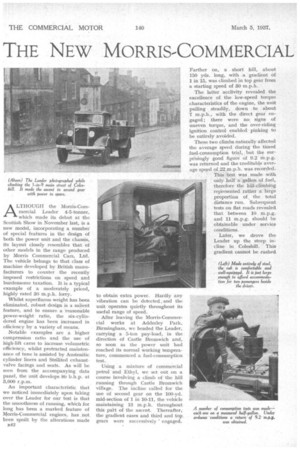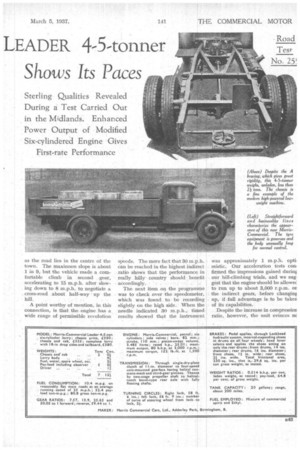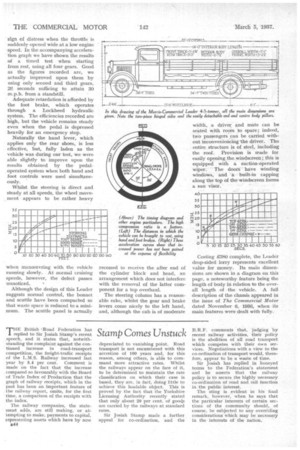THE - NEW MORRIS-COMMERCIAL LEADER 4-5-tonner
Page 60

Page 61

Page 62

If you've noticed an error in this article please click here to report it so we can fix it.
Shows Its Paces
ALTHOUGH the Morris-Commercial Leader 4-5-tonner, which made its debut at the Scottish Show in November last, is a new model, incorporating a number of special features in the design of both the power unit and the chassis, its layout closely resembles that of other models in the range produced by Morris Commercial Cars, Ltd. The vehicle belongs to that class of machine developed by British manufacturers to counter the recently imposed restrictions on speed and burdensome taxation. It is a typical example of a moderately priced, highly rated 30 m.p.h. lorry.
Whilst superfluous weight has been eliminated, robust design is a salient feature, and to ensure a -reasonable power-weight ratio, the six-cylitidered engine has been increased in efficiency.by a variety of means.
Notable examples are a higher compression ratio and the use of high-lift cams to increase volumetric efficiency, whilst protracted inaintenance of tune is assisted by Austenitic cylinder liners and Stelliteci exhaustvalve facings and seats. As will be seen from the accompanying data panel, the unit. develops 80 b.h.p. at 3,000 r. p.m.
An important characteristic that we noticed immediately upon taking over the Leader for our test is that the smoothness of running, which for long has been a marked feature of Morris-Commercial engines, has not been spoilt by the alterations made B92 to obtain extra power. Hardly any vibration can he detected , and the unit operates quietly throughout its useful range of speed.
After leaving the Morris-Commercial works at Adderley Park, Birmingham, we headed the Leader, carrying a 5-ton pay-load, in the direction of Castle Bromwich and, so soon as the power unit had reached its normal working temperature, commenced a fuel-consumption test.
Using a mixturc of commercial petrol and Ethyl, we set out on a course involving a climb of the hill running through Castle Bromwich villsge. The incline called for the use of second gear on the 100-yd. mid-section of 1 in 10-11, the vehicle maintaining 13 m.p.h. throughout this part of the ascent. Thereafter, the gradient eases and third and top gears were successively engaged. Farther on, a short hill, about 150 yds. long, with a gradient of 1 in 15, was climbed In top gear from a starting speed of 30 m.p.h.
The latter acclivity revealed the excellence of the low-speed torque characteristics of the engine, the unit pulling steadily, down to about 7 m.p.h., with the direct gear engaged ; there wore no signs of uneven torque, and the over-riding ignition control enabled pinking to be entirely avoided. These two climbs.naturally affected the average speed during the timed fuel-consumption trial, hut the surprisingly good figure of 9.2 m.p.g. was returned and the Creditable average speed oi 22 m.p.h. was recorded. This test was made with only. half a gallon of fuel, therefore the hill-climbing represented rather a large proportion of the total distance run. Subsequent tests on flat roads revealed that between 10 m.p.g. and 11 m.p.g. should be obtainable under service conditions. .
Later, we drove the Leader up the steep incline in Coleshill. • This gradient cannot be rushed as the road lies in the centre of .the town. The maximum slope is about 1 in 9, but the vehicle made a comfortable climb in second gear, accelerating to 15 m.p.h. after slowing .down to 8 m.p.h._ to negotiate a . cross-road about half-way up the hill.
• A point worthy of mention, in this connection, is that the engine has a wide range of permissible revolution speeds. The mere fact that 30 mp.h. can be reached in the highest indirect ratio shows that the performance in really hilly country should benefit accordingly.
The next item on the programme was to check over the speedometer, which was found to be recording slightly on the high side. When the needle indicated 30 m.p.h., timed results showed that the instrument
was approximately 1 m.p.h. opti, tnistic. Our acceleration tests con. firmed the impressions gained durirq our hill-climbing trials, and we sug• gest that the engine should be allower: to rim up to about 3,000 r.p.m. on the indirect gears, before changinp up, if full advantage is to be taken of its capabilities.
Despite the increase in compression ratio, however, the unit evinces tic sign of distress when the throttle is suddenly opened wide at a low engine speed. In the accompanying acceleration graph we have shown the results of a timed test when starting from rest, using all four gears. Good as the figures recorded are, we actually improved upon them by using only second and third gears, 26 seconds sufficing to attain 30 m.p.h from a standstill.
Adequate retardation is afforded by the foot brake, which operates through a Lockheed hydraulic system. The efficiencies recorded are high, but the vehicle remains steady even when the pedal is depressed heavily for an emergency stop.
Naturally the hand lever, which applies only the rear shoes, is less effective, but, fully laden as the vehicle was during our test, we were able slightly to improve upon the results obtained by the pedaloperated system when both band and foot controls were used simultaneously.
Whilst the steering is direct and steady at all speeds, the wheel movement appears to be rather heavy when manceuvring with the vehicle running slowly. At normal cruising speeds, however, the defect passes unnoticed.
Although the design of this Leader suggests normal control, the bonnet and scuttle have been compacted so that waste space is reduced to a minimum. The scuttle panel is actually
THE British ,Road Federation has replied to Sir Josiah Stamp's recent speech, and it states that, notwithstanding the complaint against the continued increase in road-transport competition, the freight-traffic receipts of the L.M.S. Railway increased last year by 5.4 per cent. Comment is made on the fact that the increase compared so favourably with the Board of Trade Index of Production that the graph of railway receipts, which in the past has been an important feature of the railway report, omits, for the first time, a comparison of the receipts with the index.
The railway companies, the statement adds, are still making, or attempting to make, payments to capital, representing assets which have by now
B44 recessed to receive the after end of the cylinder block and head, an arrangement which does not interfere with the removal of the latter component for a top overhaul.
The steering column has a reasonable rake, whilst the gear and brake levers come nicely to the left hand, and, although the cab is of moderate
width, a driver and mate can be seated with room to spare; indeed, two passengers can be carried without inconveniencing -the driver. The entire structure is of steel, including the roof. Provision is made for easily opening.the windscreen; this is equipped with a suction-operated Wiper. The doors have winding wiridoWs, and a built-in capping along the top of the Windscreen forms a sun visor.
Costing £380 complete, the Leader drop-sided lorry represents excellent value for money. Its main dimensions are shown in a diagram on this page, a noteworthy feature being the length of body in relation to the overall length of the vehicle. A full description of the chassis appeared in the issue of The Commercial Motor dated November 6, 1936, when its main features were dealt with fully.




































































































